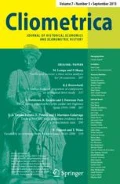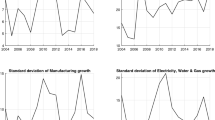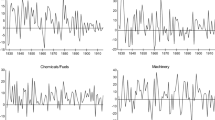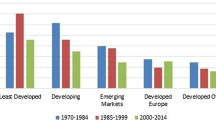Abstract
In this paper, we investigate the relationship between output volatility and growth using the standard GARCH-M framework and the US monthly industrial production index (IPI) for the period January 1919–December 2017, by taking into account the presence of shocks and variance changes. The results show that the IPI growth is strongly affected by large shocks which are associated with strikes in some industries, recessions, World War II and natural disasters. We also identify several subperiods with different level of volatility where the volatility declines along the subperiods, with the pre-WWII period (1919–1946) the highest volatile period and the aftermath period of the GFC (2010–2017) the lowest volatile period. We find no evidence of relationship between output volatility and its growth during the full sample 1919–2017 and also for all the subperiods. From a macroeconomic point of view, this implies that economic performances, as measured by IPI growth, do not depend on the uncertainty as measured by IPI volatility.




Similar content being viewed by others
Notes
See Fang and Miller (2008) for a discussion of the growth–volatility relationship.
The critical values are defined by \(g_{T,\lambda }=-\log \left( -\log (1-\lambda )\right) b_T+c_T\), with \(b_T=1/\sqrt{2\log T}\), and \(c_T=(2\log T)^{1/2}-[\log \pi + \log (\log T)]/[2(2\log T)^{1/2}]\). Laurent et al. (2016) suggest setting \(\lambda =0.5\).
Fang and Miller (2014) also detect and correct the outliers in the growth rate of real GNP using another approach. They first detect the outliers if \(|y_t-{\overline{y}}|>k\times \sigma _y\), where k measures the stringency imposed on outlier detection, and then apply the method of Ané et al. (2008) to correct the outliers identified. However, this approach is very sensitive to the value of k since when \(k=2\), 3 and 4 it identifies 36, 7 and 1 outliers, respectively. The choice of \(k=3\) by Fang and Miller (2014) is only based on the number of outliers found in previous studies.
Note that Inclán and Tiao (1994) advised that ‘it is advisable to complement the search for variance changes with a procedure for outlier detection.’
The IPI data had been seasonally adjusted by FRED prior to the analysis and are available at https://fred.stlouisfed.org/series/INDPRO.
Most of explanations associated to the detected shocks are found in the Federal Reserve Bulletin of the Board of Governors of the Federal Reserve System for the 1920–1997 period (https://fraser.stlouisfed.org) and in the Industrial Production and Capacity Utilization - G.17 of the Board of Governors of the Federal Reserve System for the 1997–2017 period (https://www.federalreserve.gov/releases/g17/).
Among the potential factors of this Great Moderation period, the literature put forward (1) ‘good practices,’ i.e.: improved inventory management (e.g., McConnell and Perez-Quiros 2000; 2) ‘good policies,’ i.e.: good monetary policy (e.g., Clarida et al. 2000; Bernanke 2004; Boivin and Giannoni 2006; Galí and Gambetti 2009); and (3) ‘good luck,’ i.e.: a decline in the volatility of exogenous shocks (e.g., Stock and Watson 2003, 2005; Ahmed et al. 2004).
We wish to thank the referee for pointing out that the GFC should not be considered as a part of the Great Moderation and thus should be excluded from the last subperiod. The results show the impact of the GFC on the summary statistics.
Under the assumption of a normal distribution \(k=3\), so the condition becomes \(3\alpha ^2+2\alpha \beta +\beta ^2<1\).
Under a normal distribution \(\delta =\frac{1}{2}\).
This problem can be explained by the very low number of observations to estimate an ARCH-M model (less than 100 observations).
Empirical evidence of the growth–volatility relationship is mixed: negative (Henry and Olekalns 2002), positive (Fountas and Karanasos 2006; Fang and Miller 2014) or no statistically significant relationship (Grier and Perry 2000; Fang et al. 2008). The disagreements can be explained by the differences in terms of the time period examined, the frequency of the data and the methodology employed.
To have a better fit for the GARCH models we focus on macroeconomic data with a high frequency. The correlation between industrial production and CFNAI is of 0.86 on the period 1967–2017.
The economic indicators are drawn from four broad categories of data: (1) production and income; (2) employment, unemployment and hours; (3) personal consumption and housing; and (4) sales, orders and inventories. The derived index provides a single, summary measure of a factor common to these economic data.
References
Ahmed S, Levin A, Wilson BA (2004) Recent U.S. macroeconomic stability: good policies, good practices, or good luck? Rev Econ Stat 86:824–32
Andersen R (2007) Modern methods for robust regression. Quantitative applications in the social sciences. London, Sage
Andersen T, Bollerslev T (1997) Intraday periodicity and volatility persistence in financial markets. J Empir Financ 4:115–158
Ané T, Ureche-Rangau L, Gambet J-B, Bouverot J (2008) Robust outliers detection for Asia–Pacific stock index returns. J Int Financ Mark Inst Money 18:326–43
Arrow KJ (1962) The economic-implications of learning by doing. Rev Econ Stud 29:155–173
Balke N, Fomby TB (1991) Shifting trends, segmented trends, and infrequent permanent shocks. J Monet Econ 28:61–85
Bernanke BS (1983) Irreversibility, uncertainty, and cyclical investment. Q J Econ 98:85–106
Bernanke BS (2004) The Great Moderation. Lecture at Eastern Ectmomic Association, Washington
Blanchard O, Simon J (2001) The long and large decline in US output volatility. Brook Pap Econ Act 2001:135–174
Black F (1987) Business cycles and equilibrium. Basil Blackwell, New York
Blackburn K (1999) Can stabilization policy reduce long-run growth? Econ J 109:67–77
Box GEP, Tiao GC (1975) Intervention analysis with applications to economic and environmental problems. J Am Stat Assoc 70:70–79
Boudt K, Daníelsson J, Laurent S (2013) Robust forecasting of dynamic conditional correlation GARCH models. Int J Forecast 29:244–257
Brunner AD (1997) On the dynamic properties of asymmetric models of real GNP. J Econ Stat 79:321–6
Caporale T, McKiernan B (1998) The Fischer black hypothesis: some time-series evidence. South Econ J 63:765–71
Carnero MA, Peña D, Ruiz E (2001) Outliers and conditional autoregressive heteroskedasticity in time series. Revista Estadistica 53:143–213
Carnero MA, Peña D, Ruiz E (2006) Effects of outliers on the identification and estimation of the GARCH models. J Time Ser Anal 28:471–497
Cecchetti SG, Flores-Lagunes A, Krause S (2006) Assessing the sources of changes in the volatility of real growth. Working paper No 11946, NBER
Charles A (2008) Forecasting volatility with outliers in GARCH models. J Forecast 27(7):551–565
Charles A, Darné O (2014) Large shocks in the volatility of the Dow Jones Industrial Average index: 1928–2013. J Bank Financ 43:188–199
Charles A, Darné O (2018) Does the Great Recession imply the end of the Great Moderation? International evidence. Econ Inq 56:745–760
Clarida R, Gali J, Gertler M (2000) Monetary policy rules and macroeconomic stability: evidence and some theory. Q J Econ 115:147–80
Darné O (2009) The uncertain unit root in real GNP: a re-examination. J Macroecon 31:153–66
Darné O, Diebolt C (2004) Unit roots and infrequent large shocks: new international evidence on output. J Monet Econ 51:1449–1465
Engle RF, Bollerslev T (1986) Modelling the persistence of conditional variances. Econom Rev 5:1–50
Engle RF, Lilien D, Robins R (1987) Estimating time varying risk premia in the term structure: the ARCH-M model. Econometrica 55:391–407
Fagiolo G, Napoletano M, Roventini A (2008) Are output growth-rate distributions fat-tailed? Some evidence from OECD countries. J Appl Econom 23:639–69
Fang W, Miller SM (2008) The great moderation and the relationship between output growth and its volatility. South Econ J 74:819–38
Fang W, Miller SM (2014) Output growth and its volatility: the Gold standard through the Great moderation. South Econ J 80:728–751
Fang W, Miller SM, Lee CS (2008) Cross-country evidence on output growth volatility: nonstationary variance and GARCH models. Scott J Political Econ 55:509–541
Fernández-Villaverde J, Rubio-Ramírez J (2010) Macroeconomics and volatility: data, models, and estimation. Working Paper No 16618, NBER
Fountas S, Karanasos M (2006) The relationship between economic growth and real uncertainty in the G3. Econ Model 23:638–47
Galí J, Gambetti L (2009) On the sources of the great moderation. Am Econ J Macroecon 1:26–57
Glosten LR, Jagannathan R, Runkle DE (1993) On the relation between the expected value and the volatility of the nominal excess return on stocks. J Finance 48:1779–1801
Grier KB, Perry MJ (2000) The effects of real and nominal uncertainty on inflation and output growth: some GARCH-M evidence. J Appl Econom 15:45–58
Hillebrand E (2005) Neglecting parameter changes in GARCH models. J Econom 129:121–138
Henry OT, Olekalns N (2002) The effect of recessions on the relationship between output variability and growth. South Econ J 68:683–92
Ho K-Y, Tsui AKC (2003) Asymmetric volatility of real GDP: some evidence from Canada, Japan, the United Kingdom and the United States. Japan World Econ 15:437–45
Inclán C, Tiao GC (1994) Use of cumulative sums of squares for retrospective detection of changes of variance. J Am Stat Assoc 89:913–923
Justiniano A, Primiceri GE (2008) The time varying volatility of macroeconomic fluctuations. Am Econ Rev 98:604–641
Lamoureux CG, Lastrapes WD (1990) Persistence in variance, structural-change, and the Garch model. J Bus Econ Stat 8:225–234
Laurent S, Lecourt C, Palm FC (2016) Testing for jumps in conditionally Gaussian ARMA-GARCH models: a robust approach. Comput Stat Data Anal 100:383–400
Lee J (2010) The link between output growth and volatility: evidence from a GARCH model with panel data. Econ Lett 106:143–145
Lee SS, Mykland PA (2008) Jumps in financial markets: a new nonparametric test and jump dynamics. Rev Finan Stud 21:2535–2563
Ling S, McAleer M (2002a) Necessary and sufficient moment conditions for the GARCH(r, s) and asymmetric power GARCH(r, s) models. Econom Theory 18:722–29
Ling S, McAleer M (2002b) Stationarity and the existence of moments of a family of GARCH processes. J Econom 106:109–17
Lucas RE (1972) Expectations and the neutrality of money. J Econ Theor 4(2):103–24
Martin P, Rogers CA (1997) Stabilization policy, learning by doing, and economic growth. Oxford Econ Papers 49(2):152–66
Martin P, Rogers CA (2000) Long-term growth and short-term economic instability. Eur Econ Rev 44(2):359–81
McConnell M, Perez-Quiros G (2000) Output fluctuations in the United States: What has changed since the early 1980’s? Am Econ Rev 90:1464–1476
Muler N, Peña D, Yohai V (2009) Robust estimation for ARMA models. Ann Stat 37:816–840
Muler N, Yohai V (2008) Robust estimates for GARCH models. J Stat Plan Inference 138:2918–2940
Newey W, West K (1994) Automatic lag selection in covariance matrix estimation. Rev Econ Stud 61:631–653
Ng HG, McAleer M (2004) Recursive modelling of symmetric and asymmetric volatility in the presence of extreme observations. Int J Forecast 20:115–129
Phelps ES (1968) Money wage dynamics and labor market equilibrium. J Polit Econ 76(4):678–711
Ramey G, Ramey VA (1995) Cross-country evidence on the link between volatility and growth. Am Econ Rev 85:1138–1151
Rodrigues PMM, Rubia A (2011) The effects of additive outliers and measurement errors when testing for structural breaks in variance. Oxf Bull Econ Stat 73:49–468
Sansó A, Aragó V, Carrion-i-Silvestre J (2004) Testing for changes in the unconditional variance of financial time series. Revista de Economía Financiera 4:32–53
Schumpeter JA (1939) Business cycles: a theoretical, historical, and statistical analysis of the capitalist process. McGraw-Hill, New York
Stock J, Watson M (1999) Forecasting inflation. J Monet Econ 44:293–335
Stock J, Watson M (2003) Has the business cycle changed? Evidence and explanation. In: The Federal Reserve Bank of Kansas City economic symposium conference proceedings, Kansas City, pp 9–56
Stock J, Watson M (2005) Understanding changes in international business cycle dynamics. J Eur Econ Assoc 3:968–1006
Summers PM (2005) What caused the Great Moderation?. Some cross-country evidence. Econ Rev 5–32
Trypsteen S (2017) The growth-volatility nexus: new evidence from an augmented GARCH-M model. Econ Model 63:15–25
Acknowledgements
We are grateful for useful comments on a previous version of this paper by anonymous referees.
Author information
Authors and Affiliations
Corresponding author
Additional information
Publisher's Note
Springer Nature remains neutral with regard to jurisdictional claims in published maps and institutional affiliations.
Rights and permissions
About this article
Cite this article
Charles, A., Darné, O. Econometric history of the growth–volatility relationship in the USA: 1919–2017. Cliometrica 15, 419–442 (2021). https://doi.org/10.1007/s11698-020-00209-y
Received:
Accepted:
Published:
Issue Date:
DOI: https://doi.org/10.1007/s11698-020-00209-y




